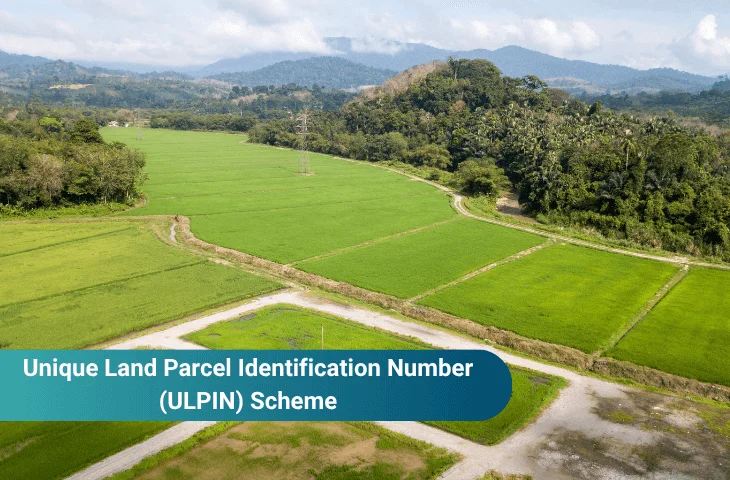The Unique Land Parcel Identification Number (ULPIN), also known as Bhu-Aadhaar, is a 14-digit alphanumeric identification number. This ULPIN uniquely identifies each surveyed land parcel in India. Developed under the Digital India Land Records Modernization Programme (DILRMP), ULPIN aims to provide a single, authoritative source of truth for land information.
Each ULPIN is generated using detailed surveys, geo-referenced cadastral maps, and precise longitude and latitude coordinates of a land parcel. This system ensures uniqueness in land identification and prevents fraud, particularly in rural areas where outdated land records often result in disputes.
The ULPIN system incorporates multiple elements such as state code, district code, sub-district code, village code, and a unique plot number, creating a standardized identification framework across India.
Why was the ULPIN Scheme Introduced?
The primary purpose of the ULPIN Scheme is to bring transparency, efficiency, and accuracy to land administration in India. Several factors necessitated the introduction of this scheme:
- Prevent Land Fraud
- Ensure Unique Transactions
- Enable Integrated Services
- Support Land Reforms and Development
- Digital India Vision
How is the ULPIN Generated?
The ULPIN is created through a combination of advanced surveying methods, geospatial technology, and standardized coding. The process involves:
- Detailed Land Surveys: Using ground surveys and satellite imagery to capture accurate boundaries and dimensions.
- Geo-Referenced Cadastral Maps: Mapping land parcels to ensure precise identification using longitude and latitude coordinates.
- Software-Based ID Generation: The Department of Land Resources (DoLR) provides software utilities that generate the 14-digit ULPIN following international standards such as ECCMA and OGC.
- Standardized Coding Structure: The number includes codes for the state, district, sub-district, village, and a unique plot ID.
Check Out: Complete List of Important Schemes for NABARD Grade A Exam
What are the Objectives of the ULPIN Scheme?
The ULPIN Scheme is not just a digitization exercise—it is part of a broader effort to modernize land administration. Its main objectives include:
- Ensuring uniqueness in land titles and preventing fraudulent transactions.
- Updating and maintaining accurate land records across all states.
- Linking all land-related departments such as the Revenue Department, Panchayat, Forest Department, and Registration Department.
- Providing affordable and accessible land services to citizens.
- Facilitating the development of an Integrated Land Information Management System (ILIMS) that integrates land records with banks, financial institutions, and other sectors.
- Enabling real-time land statistics for policy-making, land acquisitions, and developmental planning.
What are the Benefits of the ULPIN Scheme?
The ULPIN Scheme provides significant advantages for citizens, government agencies, and investors. Some of the key benefits are:
| Benefit | Description |
| Transparency and Accountability | Assigning a unique ID to each land parcel makes all transactions traceable, reducing disputes and forgery. |
| Up-to-Date Land Records | Land records are digitized and regularly updated to ensure current information. |
| Ease of Access and Integration | Single-window services allow citizens to access land information easily; departments and banks can share data seamlessly. |
| Support for Land Acquisition and Development | Accurate land data facilitates infrastructure projects, urban planning, and other development initiatives. |
| Cost-Effective Governance | Linking Aadhaar with land title deeds costs minimal resources (Rs. 3–5 per transaction), making the system efficient. |
| Economic and Policy Planning | Proper land records support agricultural planning, disaster management, financial inclusion, and urban development. |
What Challenges does the ULPIN Scheme Face?
Despite its potential, the ULPIN Scheme faces certain hurdles:
- Digital Divide: Limited digital literacy and internet access in rural areas may restrict adoption.
- Reliance on Middlemen: In areas with low awareness, people may depend on intermediaries, increasing transaction costs.
- Aadhaar-Related Issues: Mismatches in ID or biometric data may delay ULPIN linking.
- Forest Rights and Legal Conflicts: Implementation in forest areas may conflict with the Forest Rights Act (FRA), affecting tribal communities.
- Hasty Implementation Risks: Rapid rollout without resolving pending land disputes may create confusion instead of clarity.
Get ready to crack government job exams with leading educators
Role of the Digital India Land Records Modernization Programme (DILRMP) in ULPIN
The DILRMP, launched in 2008, is the overarching framework under which ULPIN operates. Key roles of DILRMP include:
- Promoting computerization of land records across all states.
- Conducting survey and resurvey operations to improve accuracy.
- Integrating registration services, banks, and financial institutions with land records databases.
- Implementing new initiatives like the National Generic Document Registration System (NGDRS) and linking revenue courts to land records.
- Enabling consent-based Aadhaar integration with land ownership records.
- Establishing an Integrated Land Information Management System (ILIMS) that consolidates land ownership, land use, taxation, boundaries, value, and encumbrances.
How does ULPIN Support Integrated Land Information Management System (ILIMS)?
The Integrated Land Information Management System (ILIMS) is designed to consolidate multiple land-related databases into a single platform. ULPIN plays a critical role in this system:
- Acts as a unique identifier linking ownership, taxation, land use, and transactions.
- Allows interdepartmental sharing of land data in real time.
- Supports financial institutions and banks in verifying collateral for loans.
- Enables governments to plan urban and rural development projects with reliable data.
- Provides a foundation for future smart city and e-governance initiatives.
What Other Government Initiatives Complement ULPIN?
Several other initiatives work alongside ULPIN to strengthen land governance in India:
- SVAMITVA Scheme
- Project Bhoomi (Karnataka)
- National Generic Document Registration System (NGDRS)
- DILRMP
- National Land Management Award
Also Check: List of Government Schemes of India
How will ULPIN Impact Citizens and Governance?
The ULPIN Scheme promises transformative effects on both citizens and governance:
| Stakeholder | Benefits of ULPIN |
| Citizens | Access to transparent and verified land records, reduced risk of fraud, faster services, and easy verification for loans or legal matters. |
| Government | Streamlined revenue collection, better urban and rural planning, reduced disputes, and improved interdepartmental coordination. |
| Investors and Developers | Reliable data for acquiring land, reducing project delays and legal risks. |
What is the Future Outlook of the ULPIN Scheme?
The future of ULPIN lies in its integration with digital governance initiatives:
- Linking land records with banks, financial institutions, and revenue courts.
- Expanding coverage nationwide by March 2022 (initially launched in 10 states in 2021).
- Integrating with smart city projects, disaster management systems, and agricultural planning.
- Continuous updates to maintain real-time accuracy and integrity of land records.
- Potential expansion to state-specific land management solutions using ILIMS as the backbone.
Key Takeaway Table
| Feature | Details |
| Full Form | Unique Land Parcel Identification Number (ULPIN) / Bhu-Aadhaar |
| Digits | 14-digit alphanumeric ID |
| Program | Digital India Land Records Modernization Programme (DILRMP) |
| Purpose | Unique identification of land parcels, prevent fraud, streamline services |
| Generated By | Department of Land Resources (DoLR) using software and geospatial data |
| Components | State code, District code, Sub-district code, Village code, Plot ID |
| Benefits | Transparency, up-to-date records, integration with banks, single-window services |
| Challenges | Digital divide, Aadhaar mismatch, FRA conflicts, dependence on middlemen |
| Complementary Initiatives | SVAMITVA, Project Bhoomi, NGDRS, National Land Management Award |
| Future | Nationwide rollout, integration with ILIMS, real-time land management |
Also Read:
Questions Based on ULPIN
- What does ULPIN stand for?
a) Unique Land Parcel Identification Number
b) Unified Land Parcel Integration Network
c) Universal Land Property Identification Number
d) Unique Legal Property Index Number
e) None of the above
Answer: a - How many digits does the ULPIN have?
a) 12
b) 14
c) 16
d) 18
e) 10
Answer: b - Which program is ULPIN a part of?
a) SVAMITVA
b) PM Kisan Samman Nidhi
c) Digital India Land Records Modernization Programme (DILRMP)
d) Project Bhoomi
e) NGDRS
Answer: c - What is the primary purpose of ULPIN?
a) Build more roads
b) Unique identification of land parcels and prevent fraud
c) Increase tax rates
d) Develop urban infrastructure
e) Provide loans to farmers
Answer: b - Which technology is used to generate ULPIN?
a) Blockchain
b) Longitude and latitude coordinates, geospatial mapping, software utilities
c) AI-based drones only
d) RFID tags
e) GPS-enabled mobile apps
Answer: b - What does ILIMS stand for?
a) Integrated Land Information Management System
b) Indian Land Identification Management System
c) International Land Information Monitoring System
d) Integrated Legal Information Management System
e) None of the above
Answer: a - Which department oversees ULPIN?
a) Ministry of Home Affairs
b) Department of Land Resources (DoLR), Ministry of Rural Development
c) Ministry of Finance
d) Ministry of Urban Development
e) Department of Agriculture
Answer: b - Which of the following is a challenge of ULPIN?
a) Digital divide in rural areas
b) Limited international recognition
c) Excessive use of AI
d) Over-reliance on blockchain
e) None of the above
Answer: a - Which initiative complements ULPIN in land digitization?
a) SVAMITVA
b) Project Bhoomi
c) NGDRS
d) All of the above
e) None of the above
Answer: d - What is the expected cost for linking Aadhaar with a land title via ULPIN?
a) Rs. 50
b) Rs. 20
c) Rs. 3–5 per transaction
d) Rs. 100
e) Free
Answer: c
- MISHTI Scheme, India’s Initiative to Restore Mangrove Ecosystems
- National Green Hydrogen Mission Features, Objectives, and Benefits
- Paramparagat Krishi Vikas Yojana, Transforming India’s Organic Farming
- Mission on Integrated Development of Horticulture NHM and HMNEH
- Swachh Bharat Mission, India’s Journey Towards Cleanliness and Hygiene
- SAGY, A Step Towards Holistic Development of Indian Villages

Hi, I’m Aditi. I work as a Content Writer at Oliveboard, where I have been simplifying exam-related content for the past 4 years. I create clear and easy-to-understand guides for JAIIB, CAIIB, and UGC exams. My work includes breaking down notifications, admit cards, and exam updates, as well as preparing study plans and subject-wise strategies.
My goal is to support working professionals in managing their exam preparation alongside a full-time job and to help them achieve career growth.
